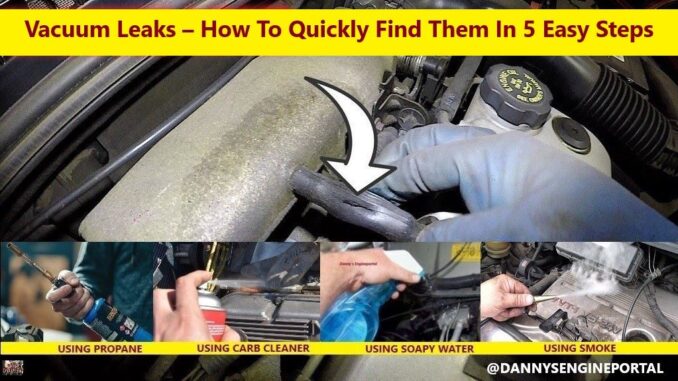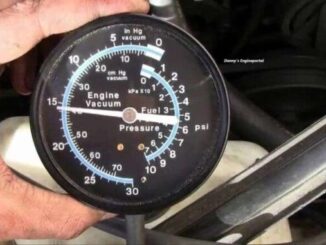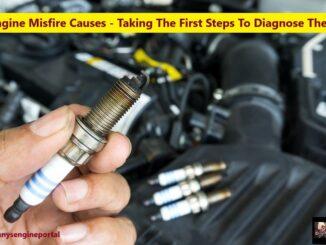
Vacuum leaks in today’s computer controlled engines, can cause very serious engine damage.
When an engine that has computer controlled spark and fuel systems, have vacuum leaks, the following events occur.
Because, these leaks pull in outside air, the fuel air ratio is altered, to a lean condition. The exhaust (O2) sensors, record this condition. Then, they report it to the (ECU).
So, vacuum leaks can cause the computer to tell the fuel system, “hey, we need more fuel”. The result of this is an oversupply of fuel that can result in a “fuel wash” condition in the cylinder.
Because, once fuel gets into the oil, it dilutes it, making it loose it’s lubricating properties. Now the oil is no longer lubricating the cylinder walls. As a result, causing metal to metal contact. The end result is scuffing of the pistons, rings and even the cylinders.
Common Symptoms Of Leaks
Vacuum leaks are one of the worst things to have. Because, they have a negative effect on many different functions of your engine. Thats why, the sooner their fixed, the better your engine will be.
Rough Or Unstable Idle:
The engine may struggle to maintain a consistent (RPM). Leading to vibrations, stumbling, or surging, especially when stopped.
Hissing Or Sucking Noises:
An audible hissing, whistling, or sucking sound coming from the engine bay. Most often caused by air being drawn in through a crack or gap. This is a definite sign of vacuum leaks.
Engine Stalling:
The engine may stall frequently, particularly at idle or when coming to a stop. And, is due to a wrong air fuel mixture that prevents proper combustion.
High Or Fluctuating (RPM)s:
The idle speed may be higher than normal, or the tachometer needle might jump up and down erratically. Usually as the engine tries to compensate for the excess air.
Poor Acceleration And Reduced Power:
The vehicle may feel sluggish, hesitate, or lack power when you press the accelerator. Because the engine is not getting the correct fuel mixture to generate power efficiently. NOTE: There is also another reason for reduced engine power that has nothing to do with vacuum leaks.
Check Engine Light (CEL) Illumination:
The (ECM) detects the lean fuel mixture (too much air, not enough fuel) via the (O2) sensors. Then, will trigger the (CEL), often storing (DTCs) like P0171 or P0174. Vacuum leaks will cause this.
Decreased Fuel Economy:
The engine works harder to compensate for the imbalance, resulting in increased fuel consumption.
Hard Or Not Starting:
The engine may be hard to start or not start at all.
Brake System Issues:
The brake booster often uses engine vacuum for power assist. So, a significant leak can result in a hard or stiff brake pedal. As a result, making it difficult to stop the vehicle.
(HVAC) System Issues:
On some vehicles, vacuum pressure controls the climate control vents. So, a leak could cause the airflow direction to operate erratically.
Next, we will show you 3 ways to find vacuum leaks. The first 2 are not the safest. But, the last one is. You will have to chose what is best for your application and skill level.
How To Quickly Find Vacuum Leaks, (not the safest way)
Follow These 5 Easy Steps:
- A faster technique for finding leaks, is to get a bottle of propane.
- First, attach a length of rubber hose to the gas valve.
- Open the valve so you have, a steady flow of gas.
- Then hold the hose near suspected leak points, while the engine is idling.
- The resulting “correction” in the air fuel ratio, should cause a noticeable change in idle speed and or smoothness.
(Note: on engines with computerized idle speed control, disconnect the idle speed control motor first). As this will aid in finding any vacuum leaks.
Computerized idle speed control is a system that maintains a stable engine idle speed. It does this by electronically regulating the amount of air bypassing the throttle plate. In older systems, an (IAC) valve is used.
But in most modern vehicles, it’s a little different. Because they use an (ETC) system. And it uses an electric motor to adjust the throttle plate position directly. The engine’s (ECU) uses sensor data to make these adjustments automatically. And, compensates for things like air conditioning or a cold engine.
You Could Also Use Aerosol Carburetor Cleaner. Again (not the safest way)
Carburetor cleaner is extremely flammable. So do not smoke or use it if there are any sparks in the vicinity. Spray the carburetor cleaner on suspected leak points, while the engine is idling. The idle speed will suddenly change and smooth out.
TIP: First, get your hands on a scan tool. Then, look at the Short Term Fuel Trim (STFT) value, while you are checking suspected areas.
When cleaner or propane is sucked in through the leak, you will see a momentary drop, in the (STFT) reading.
This confirms you have found a leak (keep checking, because there may be multiple leaks!).
In Summary: Vacuum Leaks
So, vacuum leaks are often the elusive needle in a haystack. And, if it is not a hose leaking vacuum, but something else such as a gasket, throttle shaft, injector O-rings. Then, you may never find it using this technique.
So, we have covered the quick and unsafe way to find leaks. But, we do it differently and you can read more about it here.
Vacuum Leak Detection – (The Safest Way to Find Leaks)
Above all, start with a visual inspection. Consequently, you may not have to do any testing, if you find a loose or cracked hose.
Thank you!




